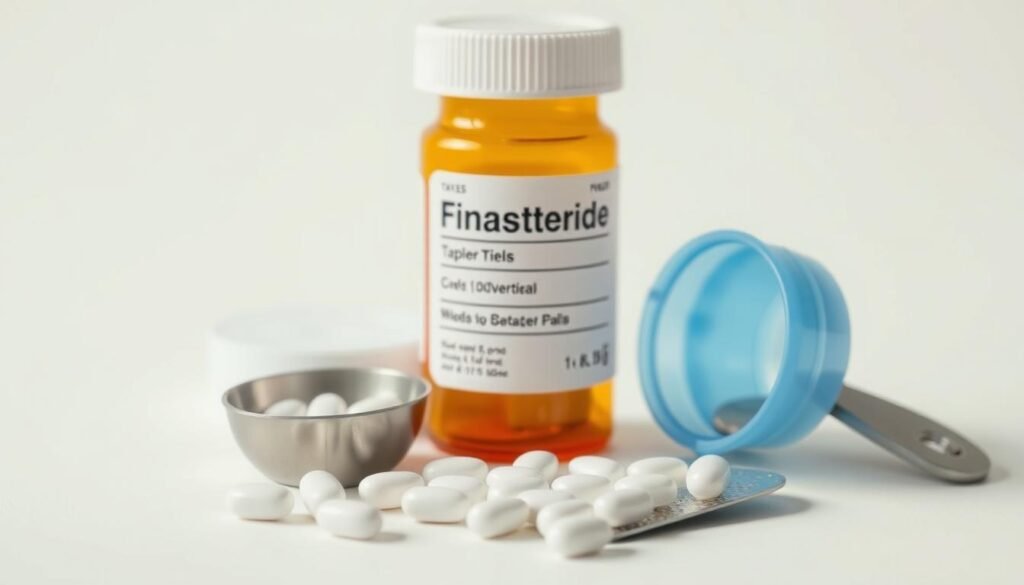About 65% of men with mild to moderate hair loss see less hair fall or more hair growth using finasteride. But, it’s key to know this FDA-approved treatment can have side effects. For those starting their journey to stop hair loss, it’s important to understand and manage these effects. This article helps by sharing crucial info on finasteride.
Key Takeaways
- Finasteride is primarily used for male pattern hair loss and benign prostatic hyperplasia.
- Understanding side effects can play a critical role in the effectiveness of hair regrowth treatments.
- Effective management strategies can help alleviate mild to serious side effects.
- Communication with healthcare providers is vital for monitoring effectiveness and side effects.
- Exploring alternatives to finasteride may provide additional options for hair loss treatment.
- Proper dosage is crucial in minimizing risks associated with the medication.
Understanding Finasteride and Its Uses
Finasteride is known for treating hair loss and enlarged prostate in men. It comes in 1 mg and 5 mg tablets. Brand names are Propecia for hair loss and Proscar for BPH. It blocks a certain enzyme, stopping testosterone from turning into DHT. High DHT levels cause hair loss and prostate problems.
For hair loss, finasteride can make hair thicker on your head. You might see changes in three months. Best results show after a year. If you stop taking it, any new hair will likely fall out in a year.
Finasteride also helps with BPH symptoms, usually improving things in six months. Yet, it can have side effects like less desire for sex and ejaculation issues. You should talk to your doctor about these risks if you’re considering it for hair loss or BPH.
How Finasteride Works for Hair Loss
Finasteride is a treatment for male pattern baldness, also known as androgenetic alopecia. It works by blocking a certain enzyme. This enzyme changes testosterone into DHT, a hormone that shrinks hair follicles. Too much DHT can make hair thin and fall out, especially in men prone to this condition.
The way Finasteride works is by stopping the enzyme that turns testosterone into DHT. Lowering DHT in the scalp by about 70% helps hair grow back. Studies show that two out of three men see hair growth after they keep taking it.
It might take six months to notice hair growth from Finasteride. If someone stops taking it, the good effects may wear off within a year. Studies have found that hair density can increase by 10% after a year of treatment.
| Effect | Details |
|---|---|
| Action Mechanism | Inhibits 5-alpha reductase enzyme |
| DHT Reduction | Levels in the scalp decrease by 70% |
| Time to See Results | Up to 6 months |
| Hair Regrowth Success Rate | Around 66% of users |
| Reversal of Benefits | Within 12 months after discontinuation |
Knowing how Finasteride works helps people choose their hair loss treatments wisely. As more people learn about it, more are interested in using it against male pattern baldness.
Common Finasteride for Hair Loss Side Effects
Individuals considering finasteride for hair loss should be aware of the medication’s side effects. Knowing these can help make informed decisions.
Mild Side Effects
Mild side effects of finasteride are quite common, affecting more than 1 in 100 people. Symptoms can include:
- Headaches
- Dizziness
- Gastrointestinal disturbances
These symptoms usually get better over time. It’s important for users to keep in touch with healthcare providers.
Moderate Side Effects
Moderate side effects can alter sexual function, cause fatigue, and lead to mood changes. A small percentage of users report these problems. People with moderate side effects should talk to their healthcare provider.
Serious Side Effects
Though rare, finasteride’s serious side effects are important health concerns. They occur in less than 1 in 1,000 people. Symptoms include:
- Low mood or depression, which can necessitate stopping the medicine
- Mastalgia, lumps, or breast swelling, possible signs of serious health issues like breast cancer
- Anaphylaxis, with signs like swelling in the mouth area, quick breathing, confusion, and dizziness
It’s vital to seek medical help right away for these symptoms. Understanding the serious side effects of finasteride is crucial for safety.
| Side Effect Type | Description | Occurrence Rate |
|---|---|---|
| Mild Side Effects | Headaches, dizziness, gastrointestinal issues | More than 1 in 100 |
| Moderate Side Effects | Changes in sexual function, fatigue, mood changes | Less common |
| Serious Side Effects | Depression, breast lumps, anaphylaxis | Less than 1 in 1,000 |
Managing Mild Side Effects of Finasteride
To handle mild side effects of finasteride, it’s key to talk with doctors and make lifestyle changes. Staying in touch with healthcare professionals is vital. Share any new symptoms to manage effects and get the best care.
Communication with Healthcare Providers
It’s vital to talk openly about any mild side effects with your doctor. This could be:
- Breast tenderness
- Dizziness
- Reduced sex drive
- Ejaculation disorders
Regular visits let your doctor check on your progress, adjust doses, and offer advice. Talking about what you’re experiencing helps build trust. This makes for a better treatment journey.
Lifestyle Adjustments
Positive lifestyle changes can help manage side effects. Doing so can boost your health. Try to:
- Eat a diet full of fruits, veggies, and grains.
- Work out often to improve mood and lessen stress.
- Get plenty of sleep for your mental health.
- Drink lots of water to avoid dizziness and tiredness.
These steps can lead to better health, supporting you while you’re on finasteride.

Handling Sexual Side Effects Associated with Finasteride
When thinking about using finasteride for hair loss, it’s key to know about the sexual side effects. Issues like erectile dysfunction and lower desire are big worries for some. Knowing about these effects helps people get ready for treatment.
Understanding Erectile Dysfunction
Erectile dysfunction affects a noticeable number of finasteride users. Studies show rates between 4.9% and 15.8%. This side effect can cause upset and stress.
But, the risk of erectile dysfunction goes down the longer you use the treatment. After five years, it often drops to 0.3%. Talking to doctors about this issue is important. They might suggest other treatments to help.
Addressing Decreased Libido
Loss of sexual desire is another common problem with finasteride. It affects between 3.1% and 5.4% of users. Talking about psychological reasons for it can help.
Talking openly with healthcare experts can offer better ways to handle it. Often, the problem gets better after stopping the treatment. Support from healthcare providers is crucial.
| Sexual Side Effect | Incidence Rate |
|---|---|
| Erectile Dysfunction | 4.9% – 15.8% |
| Decreased Libido | 3.1% – 5.4% |
| Abnormal Ejaculation | 2.1% – 7.7% |
| Long-term Effects (after 5 years) | 0.3% or lower |
Long-term Side Effects and Post-Finasteride Syndrome
When exploring finasteride for hair loss, it’s vital to know about its long-term side effects. Some individuals might face ongoing symptoms even after stopping the drug. Known as post-finasteride syndrome, this condition can include sexual, emotional, and physical issues that may not go away. It’s key to be aware of these possible outcomes before starting treatment.
Identification of Long-term Effects
It’s crucial to watch out for finasteride’s long-term effects. One major study found that 71 men had sexual dysfunction for around 40 weeks after stopping, having taken it for about 28 weeks. Remarkably, 89% still had sexual issues after 14 months. Another study showed that about 33% suffered persistent symptoms post-treatment. This suggests that long-term use could increase these risks.
Steps to Mitigate Risks
To lessen the risks, proactive steps are important. Talking regularly with healthcare providers is crucial. It allows for tracking symptoms and acting quickly if they come up. Patients should learn about post-finasteride syndrome signs and tell their doctors about any problems. Making lifestyle changes, like reducing stress and eating well, can also help. For more treatment ideas, including drug and non-drug options, check out this resource.

Exploring Finasteride Alternatives
Many people are looking for ways to fight hair loss without using finasteride. They turn to topical solutions and nutritional supplements. These options work differently to improve hair health. It’s important for them to know about these alternatives.
Topical Treatments
Topical solutions are becoming a popular choice over pills. Minoxidil is a well-known treatment that boosts hair growth by improving blood flow to the scalp. It’s applied directly, which is great for avoiding certain side effects. Dutasteride is another choice, targeting two enzymes connected to DHT production. It’s thought to be stronger for some folks.
Nutraceutical Options
Saw palmetto and pumpkin seed oil can help your hair by working on hormones, similar to finasteride. While some supplements like biotin are still being studied, eating well can support hair growth. Always talk to a doctor to find what’s best for you.
| Topical Treatments | Key Features |
|---|---|
| Minoxidil | Stimulates hair growth, applied topically, well-tolerated. |
| Dutasteride | More potent than finasteride, blocks multiple DHT-producing enzymes. |
| Nutraceutical Options | Common Benefits |
|---|---|
| Saw Palmetto | May block DHT, supports prostate health. |
| Pumpkin Seed Oil | Contains fatty acids, may promote hair health. |
The Importance of Proper Dosage
Getting the right amount of finasteride is key in treating hair loss in men. Usually, 1 mg a day is needed. For problems like enlarged prostate, doctors often recommend 5 mg daily. It’s important to follow the dosage recommendations closely. Missing a dose might not impact hair growth much, but taking it regularly is crucial for the medication to work best.
Understanding Dosage Recommendations
It’s vital patients stick to the dose their doctor prescribes. Changing the dose without a doctor’s advice can cause issues. Finasteride fights hair loss by blocking a certain hormone. Since it lasts 5 to 6 hours in the body, when you take your dose matters for the best effect. For more about finasteride, check out this resource.
Monitoring and Adjustments
Keeping an eye on how the treatment is working is necessary to adjust things if needed. This includes looking at how much hair has grown and any side effects. Finasteride is for adults over 18 and isn’t safe for children or women, especially when expecting or nursing. A well-rounded plan improves the treatment’s success. Eating well helps too, as a diet rich in proteins, vitamins, and minerals boosts the effectiveness of the medication. For dietary tips, see this guide.

Consulting with Healthcare Professionals
Talking regularly with healthcare experts is key when using or thinking about finasteride. These talks help understand the treatment and its effects on your body.
Getting professional advice helps deal with any side effects quickly. Healthcare providers can suggest changes in meds or new treatments. This keeps the treatment on track and builds a trust-filled relationship, which is key to success.
Adding treatment guidance to regular doctor visits helps patients know how they react to finasteride. Everyone responds differently, based on their genes and how well they follow the medication plan. Regular meetings allow for treatments that truly fit the patient’s needs.
It’s crucial to listen to what patients say. For some, mild side effects might come up, but these can be managed with the right advice. If there are serious side effects, it’s important to act fast. This shows why open communication with healthcare experts is so important.
| Consultation Focus | Description |
|---|---|
| Side Effect Management | Assessing and managing any side effects that arise during treatment. |
| Medication Adjustments | Making necessary changes to the treatment plan based on individual responses. |
| Alternatives Discussion | Exploring alternative treatments that may be more effective for some patients. |
| Liver Health Monitoring | Particularly for those with pre-existing conditions, ensuring liver health while on medication. |
In summary, talking to healthcare experts is crucial while on finasteride. Regular talks improve understanding and make sure the treatment suits personal health goals.
Conclusion
It’s key to know the side effects of finasteride and how to handle them. This medication helps a lot with hair loss, especially androgenetic alopecia. It affects a lot of men. Most of the time, side effects are minor and go away after a while.
Talking to your healthcare provider about finasteride is very important. If you notice side effects, discuss them. You might talk about other treatments too. This helps you choose what’s best for you. Over time, the good things about finasteride often beat the bad things. This makes treatment better for most people.
If you’re dealing with hair loss, learn about finasteride and its effects. Being knowledgeable helps you make smart choices. For more info, check out studies like this deep dive on finasteride and its effects. Knowing more can help you reach your hair health goals and handle any discomfort better.